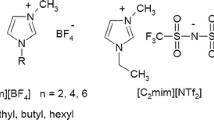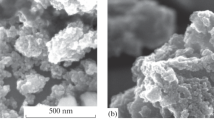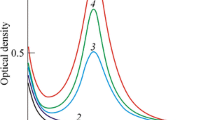Abstract
Liquid sodium containing titanium nanoparticles (LSnanop) of 10-nm diameter was prepared by dispersing titanium nanoparticles (2 at.% Ti) into liquid sodium with the addition of stirring and ultrasonic sound wave. The titanium nanoparticles themselves were prepared by the vapor deposition method. This new liquid metal, LSnanop, shows a remarkable stability due to the Brownian motion of nanoparticles in liquid sodium medium. In addition, the difference of measured heat of reaction to water between this LSnanop and liquid sodium indicates the existence of cohesive energy between the liquid sodium medium and dispersed titanium nanoparticles. The origin of the cohesive energy, which serves to stabilize this new liquid metal, was explained by the model of screened nanoparticles in liquid sodium. In this model, negatively charged nanoparticles with transferred electrons from liquid sodium are surrounded by the positively charged screening shell, which may inhibit the gathering of nanoparticles by the “Coulombic repulsion coating.” The atomic volume of LSnanop shows the shrinkage from the linear law, which also suggests the existence of cohesive energy. The viscosity of LSnanop is almost the same as that of liquid sodium. This behavior was explained by the Einstein equation. The surface tension of LSnanop is 17 % larger than that of liquid sodium. The cohesive energy and the negative adsorption may be responsible to this increase. Titanium nanoparticles in liquid sodium seem to be free from the Coulomb fission. This new liquid metal containing nanoparticles suggests the possibility to prepare various stable suspensions with new properties.





Similar content being viewed by others
References
Abu-Aljarayesh I, Abu-Libdeh A (1991) Initial susceptibility of iron in mercury magnetic fluids. J Magn Magn Mater 96:89–123
Abu-Aljarayesh I, Bayrakder A, Yusuf NA, Abu-Safla H (1993) AC magnetic susceptibility of cobalt in mercury magnetic fluids. J Appl Phys 73:6970–6972
Allen BC (1985) Surface tension. In: Ohse RW (ed) Handbook of thermodynamic and transport properties of alkali metals. International Union of Pure and Applied Chemistry, Blackwell Science Publishers, Oxford, p 691
Alonso JA, March NH (1889) Electrons in metals and alloys. Academic Press, San Diego, p 108
Andriotis AN (1993) Bimetallic interface: a periodic planar jellium approach. Phys Rev B47:6772–6775
Ara K (2007) Development of chemical reaction suppression technology of liquid sodium metal based on nanotechnology, annual report of Japan Atomic Energy Agency by the Ministry of Education, Culture, Sports, Science and Technology of Japan (MEXT), pp 3.1.2–36
Ara K, Sugiyama K, Kitagawa H, Nagai M, Yoshioka N (2010a) Study on chemical reactivity control of sodium by suspended nanoparticles I. J Nucl Sci Technol 47:1165–1170
Ara K, Sugiyama K, Kitagawa H, Nagai M, Yoshioka N (2010b) Study on chemical reactivity control of sodium by suspended nanoparticles II. J Nucl Sci Technol 47:1171–1181
Bird BB, Stewart WE, Lightfoot ED (1969) Transport phenomena. Wiley International Edition, New York, p 513
Bréchignac C, Cahuzac Ph, deFrutos M (1990) Asymmetric fission of Na ++n around the critical size of stability. Phys Rev Lett 64:2893–2896
Buffat Ph, Borel JP (1976) Size effect on the melting temperature of gold particles. Phys Rev 13A:2287–2298
Das SK, Choi SUS, Yu W, Pradeep T (2008) Nanofluids science and technology. Wiley, Hoboken
Degenkolbe J, Sauerwald F (1952) Über fie innere Reibung der Schmelzflüssigen Kalium- und Natriumamalgame. Z Anorg Allg Chem 270:317–323
Dixon TS, Charles SW, Popplewell J (1981) The effect of the addition of antimony on the physical and magnetic properties of iron particles in mercury. J Phys F 11:1931–1941
Dreirach O, Evans R, Güntherodt HJ, Kunzi HU (1972) A simple muffin tin model for the electrical resistivity of liquid noble and transition metals and their alloys. J Phys F 2:709–725
Dubois E, Chevalet J, Massart R (1999) Magnetic conductive liquids: preparation and properties of iron nanoparticles in mercury. J Mol Liq 83:243–254
Einstein A (1906) Eine neue Bestimmung der Moleküldimensionen. Ann Phys IV 19:289–305
Einstein A (1911) Berichtigung zu meimer Arbeit: Eine neue Bestimmung der Moleküldimensionen. Ann Phys IV 34:591–592
Emsley J (1999) The elements, 3rd edn. Oxford University Press, Oxford, p 216
Faber TE (1972) Introduction to the theory of liquid metals. Cambridge University Press, Cambridge, p 477
Ferrante J, Smith JR (1985) Theory of the bimetallic interface. Phys Rev B31:3427–3434
Foust OJ (1972) Sodium–NaK engineering handbook vol. I sodium chemistry and physical properties. Gordon and Breach, Science Publishers, Inc., New York
Fujita T, Park HS, Ono K, Matsuo S, Okaya K, Dodbiba G (2011) Movement of liquid gallium dispersing low concentration of temperature sensitive magnetic particles under magnetic field. J Magn Magn Mater 323:1207–1210
Fukunaga K, Ogata K, Nagai M, Oka N, Ara K, Saito J, Kitagawa H, Yamauchi M (2008) Influence factor of the nanoparticles generation by the flash vaporization method. In: Japan Institute of Metals (ed) Proceedings of the 2008 fall meeting of Japan Institute of Metals, Kumamoto, 2008, p 586
Gorse-Pomonti DG, Russier V (2007) Liquid metals for nuclear applications. J Non-Cryst Solids 353:3600–3614
Goto K (1989) Magnetic fluids. In: The forefront of physics no. 23. Kyoritsu Publishers, Tokyo, p 49
Hamaker HC (1937) The London–van der Waals attraction between spherical particles. Physica 4:1058–1072
Haynes WH, Lide DR (eds) (2010) CRC handbook of chemistry and physics, 91st edn. CRC Press, Boca Raton, pp 5–85
Hoon SR, Popplewell J, Charles SW (1979) Time dependent magnetization of iron particles in mercury ferromagnetic liquids. J Appl Phys 5:7798–7800
Hoon SR, Popplewell J, Charles SW (1982) The solid–liquid transition in mercury based magnetic fluids. J Phys F 12:2499–2507
Hudson JB (1998) Surface science introduction. Wiley–Interscience, New York, p 94
Iida T, Guthrie RO (1988) The physical properties of liquid metals. Clarendon Press, Oxford, p 132
Itami T (1995) Condensed matter–liquid transition metals and alloys. In: Srivastava AK, March NH (eds) Condensed matter-disordered solids. World Scientific, Singapore City, p 206
Ito R, Dodbiba G, Fujita T (2005) MR fluid of liquid gallium dispersing magnetic particles. Int J Mod Phys B 19:1430–1436
Japan Institute of Metals (1993) Metal data book revised edition. Trans JIM 3:16
Katakuse I, Ito H, Ichihara T (1990) Fission-like dissociation of doubly charged silver clusters. Int J Mass Spectrochem Ion Process 97:47–54
Keeting L, Charles SW, Popplewell J (1984) The prevention of diffusional growth of cobalt particles in mercury. J Phys F 14:3093–3100
Kitajima M, Itami T, Shimoji M (1974) Viscosity of liquid K–Hg alloys. Philos Mag 30:285–291
Kittel C (1967) Introduction to solid state physics, 2nd edn. Wiley, New York, p 68
Klotz IM, Rosenberg RM (2000) Chemical thermodynamics basic theory and methods, 6th edn. Wiley–Interscience Publishers, New York, p 42
Koizumi H, Sugano S, Ishii Y (1993) Shell correction study of fission of doubly charged silver clusters. Z Phys D28:223–234
Lang ND, Kohn W (1970) Theory of metallic surfaces: charge density and surface energy. Phys Rev B1:4555–4568
Lee SW (2010) Investigation of thermal conductivity of nanofluids with liquid gallium as a base fluid for heat transfer application. In: Nanofluids: fundamentals and applications II, Montreal, Canada, Aug 16
Lifshitz EW (1956) The theory of molecular attraction forces between solid bodies. Sov Phys JETP (Engl Transl) 2:73–83
Ma KQ, Liu J (2007) Nano liquid–metal fluid as ultimate coolant. Phys Lett A361:252–255
Massart JR, Rasolonjatovo B, Neveu S, Cabuil V (2007) Mercury-based cobalt magnetic fluids and cobalt nanoparticles. J Magn Magn Mater 308:10–14
Maxwell JC (1873) Treatise on electricity and magnetism. Clarendon Press, Oxford
Michaelson HB (1977) The work function of the elements and its periodicity. J Appl Phys 48:4729–4733
Misak MD (1968) Equations for determining 1/H versus S values in computer calculations of interfacial tension by the pendent drop method. J Colloid Interface Sci 27(1):141–142
Nozaki K, Itami T (2004) Dual Percolation Transition of an ionic conductor in the AgI–BN composite system. J Phys Condens Matter 16:7763–7767
Nozaki K, Itami T (2006a) The determination of the full set of characteristic values of percolation, percolation threshold, and critical exponents for the artificial composite with ionic conduction Ag4RbI5–(β-AgI). J Phys Condens Matter 18:2191–2198
Nozaki K, Itami T (2006b) The evolution of the ionic conduction of (AgI) x –(Ag2O)y–(B2O3)1-(x + y) glasses containing nanocrystallites of α-AgI. J Phys Condens Matter 18:3617–3627
Nozaki K, Itami T (2007) Ionic conduction in heterogeneous systems containing superionic conductors. In: Das MP (ed) Condensed matter: new research. Nova Science Publishers, New York, pp 191–220
Ohshima K, Harada J (1984) An x-ray diffraction study of soft surface vibrations of FCC fine metal particles. J Phys C 17:1607–1616
Park HS, Cao LF, Dodbiba G, Fujita T (2009) Liquid gallium based temperature sensitive functional fluid dispersing chemically synthesized FeMB nanoparticles. J Phys Conf Ser 149:012108, 1–5
Popplewell J, Charles SW, Hoon SR (1976) The long term stability of metallic ferromagnetic liquid. In: IEEE conference no. 142, pp 13–16
Popplewell J, Charles SW, Boon SR (1980) Aggregate formation in metallic ferro-magnetic liquids. IEEE Trans Magn 16:191–196
Raims S (1967) The wave mechanics of electrons in metals. North-Holland Publishers, Amsterdam, p 194
Rosenweig RG (1985) Ferrohydrodynamics. Cambridge University Press, Cambridge, p 36
Safran SA (1994) Statistical thermodynamics of surfaces, interface and membranes. Perceus Books, Cambridge
Saito J, Ara K (2010) A study of atomic interaction between suspended nanoparticles and sodium atoms in liquid sodium. Nucl Eng Des 240:2664–2673
Saunders WA (1990) Fission and liquid-drop behavior of charged gold clusters. Phys Rev Lett 64:3046–3049
Shimoji M (1977a) Liquid metals. Academic Press, London, p 110
Shimoji M (1977b) Liquid metals. Academic Press, London, p 96
Shimoji M (1977c) Liquid metals. Academic Press, London, p 109
Shimoji M, Itami T (1986) Atomic transport in liquid metals. Trans Tech Publishers, Zurich, p 32
Shpil’rain EE, Yakimovich KA, Fomin VA, Skovorodjko SN, Mozgovoi AG (1985a) Density and thermal expansion of liquid alkali metals. In: Ohse RW (ed) Handbook of thermodynamic and transport properties of alkali metals. International Union of Pure and Applied Chemistry, Blackwell Science Publishers, Oxford, p 435
Shpil’rain EE, Yakimovich KA, Fomin VA, Skovorodjko SN (1985b) Thermal conductivity in the liquid phase. In: Ohse RW (ed) Handbook of thermodynamic and transport properties of alkali metals. International Union of Pure and Applied Chemistry, Blackwell Science Publishers, Oxford, p 753
Sugano S, Koizumi H (1998a) Microclusters. Springer, Berlin, p 50
Sugano S, Koizumi H (1998b) Microclusters. Springer, Berlin, p 78
Thermodynamic Database Group (1992) Japan Society of Calorimetry and Thermal Analysis, materials-oriented little thermodynamic database for PC (MALT2). Kagaku Gijutsu-Sha, Tokyo
Thompson R (1981) The stability of metal particles and particle–plate interactions in liquid metals. In: Borgstedt HU (ed) Material behavior and physical chemistry in LIQUID METAL SYSTEMS. Plenum Press, New York, p 455
Wong K, Tikhonov G, Kresin V (2002) Temperature-dependent work functions of free alkali-metal nanoparticles. Phys Rev B66:125401-1-5
Acknowledgments
The present study is part of the program, “Development of Chemical Reaction Suppression Technology of Liquid Sodium Metal Based on Nanotechnology” entrusted to Japan Atomic Energy Agency by the Ministry of Education, Culture, Sports, Science and Technology of Japan (MEXT).
Author information
Authors and Affiliations
Corresponding author
Rights and permissions
About this article
Cite this article
Saito, Ji., Itami, T. & Ara, K. The preparation, physicochemical properties, and the cohesive energy of liquid sodium containing titanium nanoparticles. J Nanopart Res 14, 1298 (2012). https://doi.org/10.1007/s11051-012-1298-2
Received:
Accepted:
Published:
DOI: https://doi.org/10.1007/s11051-012-1298-2




